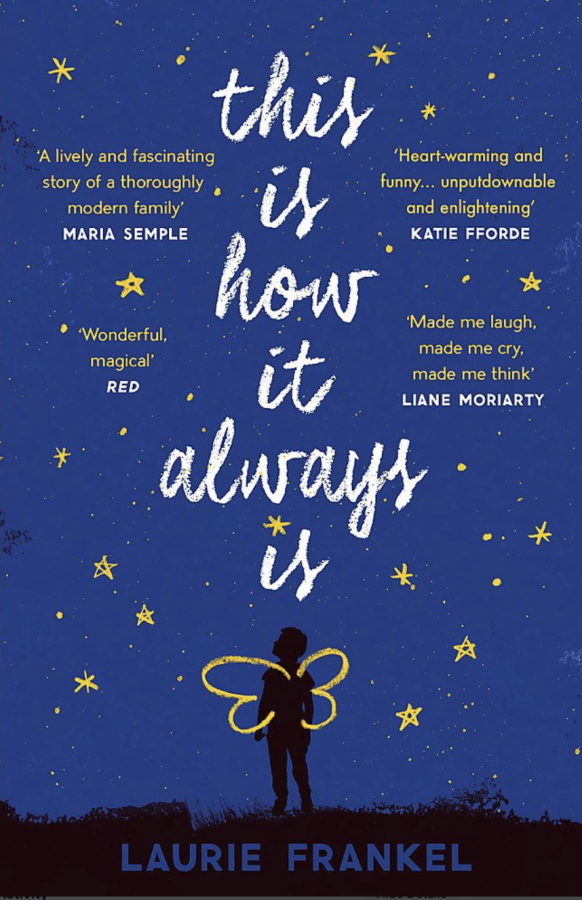This is How It Always Is: The Option of Choosing ‘Other’
May 27, 2022
“Is it always ‘or’? Is it never ‘and’?” —Stephen Sondheim, Into the Woods. This is the first epigraph of This is How It Always Is by Laurie Frankel. In this novel, readers are introduced to the lively Walsh-Adams family. There’s Penn, the father, an aspiring novelist struggling to finish his first book. There’s Rosie, the mother, an E.R. physician turned private practice clinician. Then, there’s Rosie and Penn’s five kids.
Their eldest is Roosevelt Walsh-Adams, known as Roo. There’s not much to say about Roo besides that he’s the oldest, and becomes a typical rebellious teen halfway through the novel. Ben is the second born, a year younger than Roo, and is such a genius that his parents decide for him to skip a grade. After Ben comes the twins Rigel and Orion, two adventurous and loveable goofballs.
After having four sons, Rosie longs to have a daughter and, for a moment, turns to superstition to manifest one. Her youngest child, however, was a fifth son named Claude. Even from an early age, Claude expresses how much he wants to be a girl, choosing the name Poppy—after Rosie’s late sister who died of childhood cancer—and changing pronouns from he to she.
The novel starts with developing Penn and Rosie’s relationship: readers slowly learn how they met and eventually started a family together. Chapters oscillate between Penn and Rosie’s memories, and the present, but the present also spans from Poppy’s birth to when she’s age 10. Most of the book delves into the daily life of this seven-person family, and especially the inner struggles of Poppy discovering who she really is.
What’s notable is that the book can appeal to both adults and adolescents alike. Older readers can relate to Penn and Rosie’s many conversations about parenting or the occasional suggestive joke. Adolescent readers can identify with the struggles of being an awkward preteen or gullible teen discovering themselves.
Frankel addresses societal expectations of gender in both western and eastern cultures (part of the novel takes place in Thailand where Rosie was sent as a traveling doctor) and how transgender people navigate those expectations. Going back to the first epigraph, the novel explores the idea of being both boy and girl, in a world where children are taught to only choose one.
While the average person may not relate to the novel’s depictions of gender dysphoria1, readers may still connect with genuine portrayals of bullying, self-discovery, and family dynamics. As someone who is genderfluid, I found myself teary eyed at first, but then bawling my eyes out at the heartbreaking descriptions of Poppy trying to be herself. I could relate to wanting to hide who you are because you feel ashamed, because you feel like your family doesn’t and won’t ever understand who and what you are. Poppy wanted to disappear; she made herself smaller and smaller in family drawings, drawing herself in white and eventually not drawing herself at all. There’s more to this situation, but I’ll leave that for you to discover—it truly broke my heart.
I found myself laughing, crying, or both at least once a chapter. From Poppy’s kindergarten class questioning why she’s wearing a dress when first transitioning2 to the scene where Roo berates his parents for not truly loving his sister, readers are ensnared in the Walsh-Adams family’s heartening spectacle. The five siblings, each unique and talented in their own right, have what is probably fiction’s best pair of parents to ever exist. Rosie and Penn loved and protected their kids to the point where a psychologist they talked to recommended that Poppy needed to suffer more. The two of them want nothing more than to see their kids happy, and that fact is evident in each forehead kiss, hug, conversation, argument, and bedtime story they have with their family.
This is How It Always Is is a truly wholesome and heartwarming tale for nearly all readers. With so many layers to its story, this book successfully introduces dozens of characters that readers get to know really well. The connections and relationships between many of the characters are incredibly sweet, and the narrations leave much more beyond what is said; the writing is amazingly well done. I cannot recommend it enough.
1: A mental state, often exhibiting depression, where a person feels highly uncomfortable identifying with the gender they were assigned at birth, and is uncomfortable with their body because of it.
2: When a transgender person publicly shifts from their assigned gender at birth to their preferred (or true) gender.






